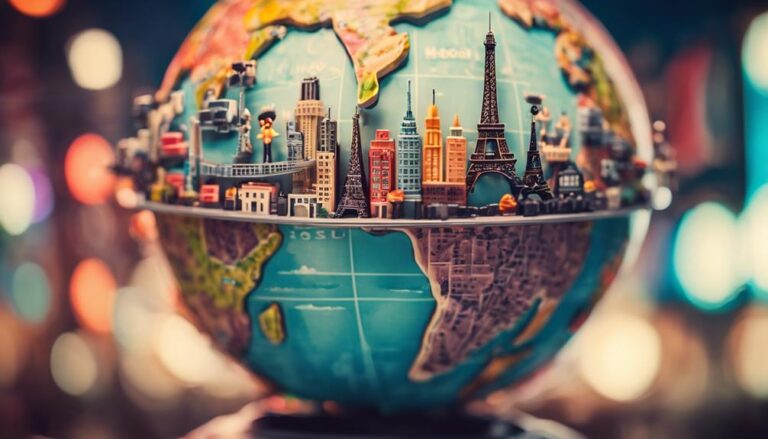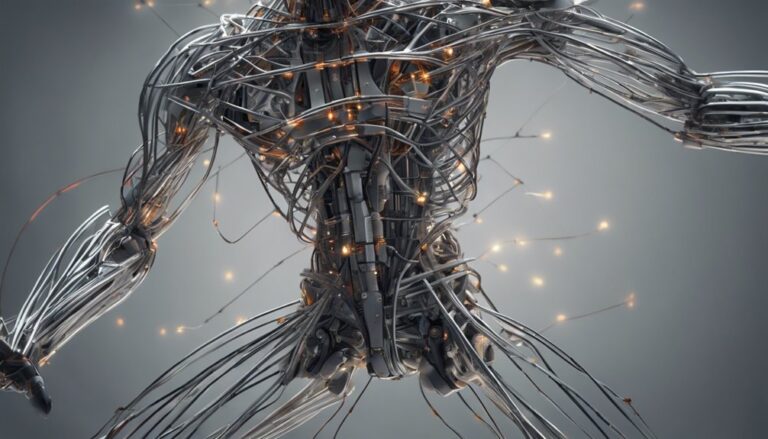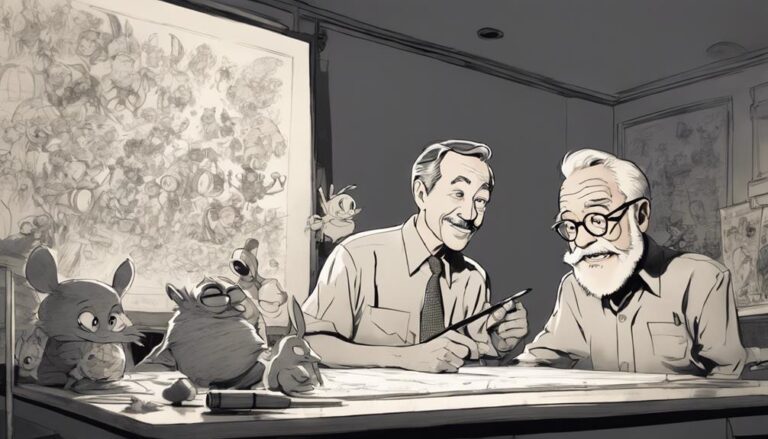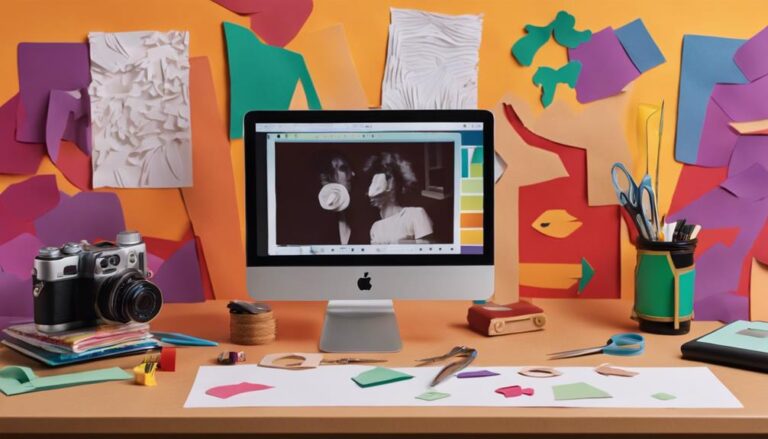What Role Does Hand-Drawn Animation Play Today?
You might wonder what role hand-drawn animation plays today, given the dominance of computer-generated imagery (CGI) in modern media. However, hand-drawn animation continues to thrive, with its distinctive aesthetic and versatility enchanting audiences in films, TV shows, video games, and advertising. Traditional techniques are still employed in innovative ways, from seamlessly integrating hand-drawn elements into visual storytelling in films to creating memorable commercials that evoke a sense of nostalgia. As you explore this topic further, you'll discover how hand-drawn animation is evolving, combining traditional methods with digital tools to create sophisticated and complex visual effects, opening up new creative possibilities.
Key Takeaways
- Hand-drawn animation continues to play a significant role in modern filmmaking, TV shows, video games, and advertising, offering unique visual storytelling opportunities.
- The integration of digital tools has enabled the development of hybrid techniques, combining traditional hand-drawn methods with computer-generated imagery (CGI).
- Hand-drawn animation is used in various forms of media to evoke nostalgia, create memorable characters, and convey complex emotions and ideas.
- The resurgence of traditional animation techniques in modern media has led to a proliferation of hand-drawn animation in popular series and films.
Evolution of Hand-Drawn Techniques
As you plunge into the world of hand-drawn animation, you'll notice that techniques have undergone significant transformations since the early 20th century, with pioneers like Winsor McCay and Émile Cohl experimenting with rudimentary methods that laid the groundwork for modern practices.
The advent of the Digital Era has revolutionized the field, granting artists unprecedented Artistic Freedom to explore new styles and techniques.
With the rise of computer software, animators can now create, edit, and refine their work with greater ease and precision.
The integration of digital tools has also enabled the development of hybrid techniques, combining traditional hand-drawn methods with computer-generated imagery (CGI).
This fusion has led to the creation of sophisticated and complex visual effects, as seen in films like 'Spider-Man: Into the Spider-Verse' and 'The Lego Movie'.
Furthermore, digital software has streamlined the production process, allowing for faster iteration and experimentation.
As a result, hand-drawn animation has become more accessible and versatile, empowering artists to push the boundaries of storytelling and visual expression.
Traditional Animation in Modern Films
Within the domain of modern filmmaking, traditional animation techniques continue to be employed in innovative ways, with many contemporary films seamlessly integrating hand-drawn elements into their visual storytelling.
You'll notice that traditional animation is often used in conjunction with computer-generated imagery (CGI) to create a unique visual aesthetic. This blending of techniques allows filmmakers to tap into the nostalgia of traditional animation while still benefiting from the efficiency and versatility of CGI.
The resurgence of traditional animation in modern films can be attributed, in part, to the Film Revival of the 1990s, which saw a renewed interest in hand-drawn techniques.
This revival paved the way for artists to experiment with traditional animation, pushing the boundaries of what's possible within the medium. With the artistic freedom to explore different styles and techniques, filmmakers can now create visually stunning and emotionally resonant films that appeal to a wide range of audiences.
Hand-Drawn Animation in TV Shows
The resurgence of traditional animation techniques in modern television shows has led to a proliferation of hand-drawn animation in popular series, with many networks and streaming platforms now incorporating this style into their programming. You're likely familiar with the nostalgic feel of hand-drawn animation, which has been a staple of TV nostalgia for decades. Cartoon revivals, such as the reboot of "ThunderCats" and "Voltron," have also contributed to the resurgence of hand-drawn animation in TV shows.
| TV Show | Style |
|---|---|
| Adventure Time | Fantasy-based hand-drawn animation |
| Steven Universe | Magical realism with hand-drawn elements |
| OK K.O.! Let's Be Heroes | Action-comedy with hand-drawn animation |
| The Amazing World of Gumball | Mixed media with hand-drawn elements |
| Regular Show | Offbeat humor with hand-drawn animation |
As you can see, hand-drawn animation is being used in a variety of TV shows, from fantasy-based series like "Adventure Time" to action-comedies like "OK K.O.! Let's Be Heroes." The use of hand-drawn animation in TV shows has allowed creators to push the boundaries of storytelling and visuals, resulting in unique and engaging programming. By incorporating traditional animation techniques, TV shows can evoke a sense of nostalgia while still feeling fresh and modern.
The Rise of Indie Animation
Independent animators and studios are driving innovation in the animation industry, leveraging digital tools and social media platforms to produce and distribute their own content, often characterized by experimental styles, unique storytelling, and niche themes.
As you explore the world of indie animation, you'll notice a distinct indie spirit that permeates every aspect of production. This spirit is fueled by creative freedom, allowing artists to take risks and push boundaries that might be impossible in traditional studio settings.
With the rise of digital platforms, indie animators can now reach global audiences without the need for traditional distribution channels.
This has led to a proliferation of innovative and often genre-bending content that resonates with niche audiences. You'll find that indie animation often prioritizes artistic expression over commercial appeal, resulting in a rich tapestry of diverse styles and themes.
As you plunge deeper into the world of indie animation, you'll discover a vibrant community of artists who are redefining the boundaries of hand-drawn animation.
Hybrid Animation Methods
As you explore the domain of hand-drawn animation, you'll notice a growing trend towards hybrid animation methods that merge traditional techniques with modern technology.
By combining 2D and 3D elements, animators can create visually striking and complex scenes that wouldn't be possible with traditional methods alone.
You'll see how digital painting techniques and the integration of technology can enhance the traditional hand-drawn animation process, opening up new creative possibilities.
Combining 2D and 3D
By leveraging hybrid animation methods that seamlessly blend traditional hand-drawn techniques with 3D computer-generated imagery, artists and filmmakers can trigger innovative creative possibilities, opening doors to exciting visual and storytelling avenues that may have previously seemed unimaginable.
You can combine the best of both worlds by integrating hand-drawn elements into 3D environments or vice versa, creating a unique visual fusion that captivates audiences.
When combining 2D and 3D, you can experiment with mixed media techniques, such as incorporating hand-drawn textures into 3D models or using 3D software to enhance traditional animation.
This hybrid approach allows for greater flexibility and creative control, enabling you to achieve complex visuals and nuanced storytelling.
Digital Painting Techniques
Embracing the versatility of digital painting techniques within hybrid animation methods, you can leverage software such as Adobe Animate or Toon Boom Harmony to create intricate, layered designs that seamlessly merge traditional hand-drawn aesthetics with cutting-edge digital tools. This fusion of old and new enables you to refine your digital artistry, experimenting with various brush strokes and textures to achieve unique visual effects.
Within these software platforms, you can mimic traditional media, such as watercolor or oil painting, using customizable brushes that simulate the organic feel of hand-drawn techniques. By manipulating digital brush strokes, you can add subtle nuances to your animation, imbuing characters and environments with a sense of depth and dimensionality.
As you master digital painting techniques, you'll be able to streamline your workflow, making it easier to iterate and refine your designs. This, in turn, allows you to focus on the creative aspects of your project, pushing the boundaries of what's possible in hybrid animation. By embracing the intersection of traditional and digital techniques, you'll discover new possibilities for artistic expression and visual storytelling.
Traditional Meets Technology
Technology plays a significant role in bridging the gap between traditional hand-drawn techniques and modern animation methods, allowing for the creation of innovative, hybrid animation styles.
The answer lies in the sphere of digital fusion, where traditional hand-drawn techniques meet cutting-edge technology. By combining the two, you can release new levels of artistic freedom and create unique, enthralling animations.
Digital painting software can be utilized to create digital versions of your hand-drawn artwork, experimenting with various brushes and textures to achieve the desired look. Software like Adobe Animate or Toon Boom Harmony can be used for this purpose.
3D modeling and animation can be incorporated into your hand-drawn animations using software like Blender or Autodesk Maya, adding depth and complexity to your scenes.
Motion capture technology can be used to record and translate real-world movements into digital animations, creating realistic character movements and interactions.
Automated rigging and tweening tools can be taken advantage of to streamline your animation process, allowing you to focus on the creative aspects of your project.
Hand-Drawn Video Game Cutscenes
Developers who create hand-drawn video game cutscenes typically rely on software packages like Adobe Animate, Toon Boom Harmony, or OpenToonz to manage the process, from scanning hand-drawn artwork to implementing keyframe animation and compositing.
You'll notice that these cutscenes often evoke a sense of nostalgia, reminiscent of classic cartoons or anime. This is no coincidence, as developers aim to create a distinct visual style that sets their game apart from others. By incorporating hand-drawn elements, they can tap into the player's emotional connection to the game world.
When it comes to gameplay integration, hand-drawn cutscenes can be used to great effect. You can use them to convey important story beats, provide context for the player's actions, or simply to create a sense of atmosphere.
By seamlessly integrating these cutscenes into the gameplay experience, developers can create a more immersive and engaging experience for the player. For example, a hand-drawn cutscene might be used to introduce a new character or location, setting the stage for the player's next objective.
Preserving Traditional Animation Skills
By actively incorporating hand-drawn techniques into their workflow, studios can help preserve traditional animation skills that are at risk of being lost in the shift to computer-generated imagery (CGI) and automated animation tools.
As you consider the importance of preserving traditional animation skills, you'll realize that it's not just about nostalgia – it's about maintaining artisanal craftsmanship and cultural significance.
Mentorship programs pair experienced animators with newcomers to pass on techniques and knowledge.
Workshops and training offer regular sessions to help animators develop and refine their hand-drawn skills.
Hybrid workflows combine traditional techniques with digital tools to create a unique and efficient workflow.
Archival and preservation document and preserve traditional animation techniques, processes, and artwork for future generations.
The Art of Storyboarding
As you begin to develop your storyboarding skills, you'll need to focus on visual development, which involves creating a cohesive visual language for your animation.
This process requires you to think critically about the pacing of your story, ensuring that each scene flows logically into the next.
Storyboard Visual Development
You'll typically begin the storyboarding process by creating a series of rough thumbnail sketches, known as a 'thumbnail board,' to visualize the pacing, camera angles, and overall flow of your animation.
This vital step allows you to distill your visual storytelling into a concise and coherent narrative. As you refine your concept, you'll start to see the pacing, tone, and emotional resonance of your animation take shape.
During this stage, you'll focus on concept refinement, ensuring that every element serves the story.
Visual storytelling: How will you convey key plot points and character emotions through visual elements?
Camera angles and movement: How will you use camera placement and movement to create tension, emphasize important moments, or guide the viewer's attention?
Pacing and timing: How will you balance action, dialogue, and quiet moments to create a engaging rhythm?
Story beats: How will you break down your narrative into key events and turning points to create a compelling arc?
Refining Story Pacing
Refining story pacing is a crucial step in the storyboarding process, where you deliberately control the speed and rhythm of your narrative to engage your audience and heighten emotional impact. By adjusting the pacing, you can create a more dynamic and immersive experience for your viewers. To refine your story pacing, you'll need to weigh the emotional resonance of each scene and how it contributes to the overall narrative arc.
| Pacing Techniques | Emotional Resonance | Storyboarding Tips |
|---|---|---|
| Quick cuts | High-energy action sequences | Use short, snappy panels to create a sense of urgency |
| Long takes | Emotional character moments | Employ longer, more contemplative panels to build emotional depth |
| Montage sequences | Establishing setting and atmosphere | Use a mix of short and long panels to create a sense of rhythm and flow |
| Time dilation | Creating tension and suspense | Manipulate time and space to build anticipation and unease |
| Freeze frames | Highlighting key moments | Use static panels to emphasize important plot points or character beats |
Hand-Drawn Animation in Advertising
Many advertisers have successfully leveraged hand-drawn animation to create engaging, memorable commercials that resonate with their target audience. You're likely familiar with the charming, whimsical ads that have become synonymous with hand-drawn animation.
But what makes this style so effective in advertising? For one, hand-drawn animation offers a unique opportunity for brand storytelling. Ad agencies often prefer this style because it allows for a more personal, emotive connection with the viewer.
When it comes to hand-drawn animation in advertising, several key elements contribute to its success:
Emotional resonance: Hand-drawn animation has a way of evoking emotions, making it an excellent choice for brands looking to create a connection with their audience.
Brand differentiation: In a sea of CGI-heavy ads, hand-drawn animation stands out, offering a revitalizing alternative that can help brands differentiate themselves.
Storytelling flexibility: Hand-drawn animation allows for a wide range of storytelling styles, from simple and straightforward to complex and nuanced.
Timeless appeal: Hand-drawn animation has a timeless quality that can make ads feel less dated, even years after their initial release.
Future of Hand-Drawn Animation
As the animation industry continues to evolve, hand-drawn animation is poised to adapt and thrive, driven by advancements in digital tools and a growing appreciation for traditional craftsmanship.
You're likely to see a resurgence of hand-drawn techniques in various forms of media, from feature films to virtual reality experiences.
New frontiers in animation technology, such as AI-powered drawing tools and real-time rendering, will enable artists to push the boundaries of traditional hand-drawn animation.
Industry trends suggest that there will be a greater emphasis on hybrid approaches, combining hand-drawn techniques with computer-generated imagery (CGI).
This fusion of styles will allow animators to create complex, detailed environments and characters while maintaining the unique charm of hand-drawn animation.
As a result, you can expect to see more innovative and visually stunning productions that blend the best of both worlds.
With the rise of streaming platforms and online content, there will be more opportunities for hand-drawn animators to showcase their work and connect with audiences worldwide.
Frequently Asked Questions
Can Hand-Drawn Animation Be Used in Virtual Reality Experiences?
You're pushing boundaries in VR, incorporating hand-drawn animation to create immersive storytelling within virtual worlds. This approach adds an artistic touch, increasing user engagement through interactive, fantastical environments that draw from your creative vision.
How Does Hand-Drawn Animation Impact Film Budgets?
You face budget constraints when using hand-drawn animation, as it can be time-consuming and labor-intensive. You'll need to balance financial limitations with artistic vision, allocating resources effectively to stay within budget and meet project deadlines.
Are Hand-Drawn Animators in High Demand Today?
You'll find that hand-drawn animators are in high demand today, especially with the resurgence of traditional techniques in modern productions. Industry trends show a growing need for skilled artists, offering diverse career paths in film, TV, and commercials.
Can Hand-Drawn Animation Be Used in Live-Action Films?
You can seamlessly integrate hand-drawn animation into live-action films, enhancing visual storytelling. By combining traditional techniques with modern technology, you create mesmerizing hybrid scenes, blending the best of both worlds for a unique cinematic experience.
Do Hand-Drawn Animators Need to Know Computer Programming?
When working on a project, you'll likely need to collaborate with programmers, so having basic coding skills can be beneficial. However, your primary focus will be on artistic freedom, allowing you to maintain creative control over your hand-drawn animations.
Conclusion
You're witnessing a resurgence of hand-drawn animation in modern media.
With the rise of indie animation and hybrid methods, traditional techniques are being reimagined and refined.
As technology advances, artists can now seamlessly blend hand-drawn and digital elements, creating unique visual styles.
The art of storyboarding remains a pivotal step in the animation process, and hand-drawn animation continues to thrive in advertising, film, and TV.
Its future is bright, with innovative applications and artistic expressions emerging.







